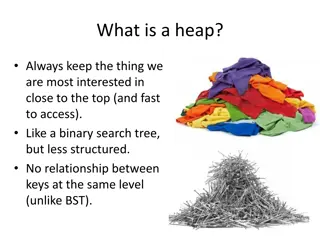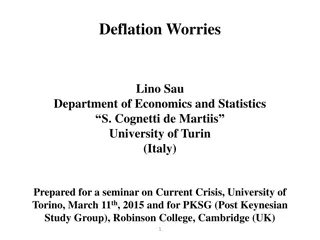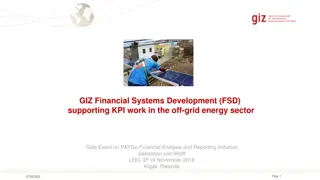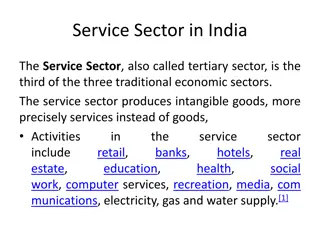Financial Services Sector Overview: Max M. Fisher College of Business Presentation
Sector presentation on Financial Services by William Quirk, Nick Stamatis, Sharon Tong, and Carolina Tovar from Max M. Fisher College of Business. The presentation covers the market size, performance, industries, top companies, and business analysis of the sector. It highlights the sector's performance in relation to the S&P 500 index, external factors influencing its growth, and the importance of technology and mergers and acquisitions for driving future growth.
Download Presentation

Please find below an Image/Link to download the presentation.
The content on the website is provided AS IS for your information and personal use only. It may not be sold, licensed, or shared on other websites without obtaining consent from the author. Download presentation by click this link. If you encounter any issues during the download, it is possible that the publisher has removed the file from their server.
E N D
Presentation Transcript
MAX M. FISHER COLLEGE OF BUSINESS Sector Presentation: Financial Services William Quirk, Nick Stamatis, Sharon Tong and Carolina Tovar 1
OVERVIEW 2
Sector Overview: Size of Sector Market Cap: 7.58 T 1. Percentage of S&P500: 31.5% of S&P 500 (24.06 T) 1. Sector Overview: Performance Financial Sector 1 year percentage change : 35.32% 1. S&P 500 Index 1 year percentage change: 19.79% 2. 3
Sector Overview: Industries Banks 1. Capital Market 2. Consumer Finance 3. Diversified Financial Services 4. Insurance 5. Mortgage REITs 6. Thrifts & Mortgage Finance 7. 6
Sector Overview: Largest Companies J P Morgan Chase &Co: 345.27B Bank of America Corporation: 284.13B Wells Fargo & Company: 270.64B HSBC Holdings plc: 198.59B Citigroup Inc.: 194.41B Royal Bank of Canada: 116.99B Banco Santander, S.A.: 105.23B Toronto Dominion Bank: 105.05B Goldmans Sachs Group, Inc.: 94.68B 7
Business Analysis: Life Cycle The financial sector performs best during the growth and maturity phases of the business cycle. This is when corporate earnings and interest rates are highest The financial sector struggles in later parts of the business cycle as it is a cyclical industry, and is subject to losses as the economy falters Current bull run for stocks ---> strong growth Interest rate hikes Increasing reliance on technology, M&A to drive growth 9
Business Analysis: External Factors Overall state of the U.S. and global economy Capital projects, personal saving/investing levels rise More loans=more money Interest rates 1.25%, last raised in June 2017 Subject to increased future raises Banks, insurance industries Monetary/fiscal policy Quantitative Easing, TARP 10
Business Analysis: Supply/Demand Users include the vast majority of individual consumers, corporations globally Market is massive: 34 banks in the United States have over $100 billion in assets, including 4 over $1 trillion (JPM, BAC, WFC, C) Primarily saturated markets in developed countries Room for expansion in developing markets--microfinance, booming business development Demand is driven by: Consumer preferences for risk/expectations of the future Strength of the economy Investment opportunities 1. 2. 3. 11
Business Analysis: Porters Five Forces Barriers to Entry: MODERATE Incumbents have extensive brand recognition and customer loyalty Network effect Local credit unions and regional banks that were comparably risk-averse during the recession have had success and strengthened over the recent time period Supplier Power: MODERATE In this case, the supplier is primarily the customer Individuals/institutions can choose which bank to conduct business with based on customer service, rates offered, convenience and other perks 12
Business Analysis: Porters Five Forces Continued Buyer Power: MODERATE Very similar to supplier power, as the customer/institution both buys capital (mortgages, loans) and supplies capital (savings accounts, CDs) Threat of Substitutes: LOW The financial sector is necessary to maintain adequate levels of liquidity in the markets Companies are unable to compete without sufficient funds, so there are no substitutes Competitive Rivalry: HIGH Companies battle for market share, focus on niche markets/regions, offer different services 13
S&P vs Sector & Sub-Sector - Sales Key S&P 500 Index SPX Financials Sector Subsectors: Insurance Banks Diversified 22
S&P vs Sector & Sub-Sector - Profit Margin Key S&P 500 Index SPX Financials Sector Subsectors: Insurance Banks Diversified 23
S&P vs Sector & Sub-Sector - ROE Key S&P 500 Index SPX Financials Sector Subsectors: Insurance Banks Diversified 24
S&P vs Sector & Sub-Sector - Earnings per Share Key S&P 500 Index SPX Financials Sector Subsectors: Insurance Banks Diversified 25
S&P vs Sector & Sub-Sector - Cash Flow Key S&P 500 Index SPX Financials Sector Subsectors: Insurance Banks Diversified 26
S&P vs Sector & Sub-Sector - Capital Expenditures Key S&P 500 Index SPX Financials Sector Subsectors: Insurance Banks Diversified 27
S&P 500 v. S5FINL 29 All numbers as of 10/20/2017
S&P 500 v. S5FINL Absolute High Low Median Current S&P 500 24.17 Financials S&P 500 Financials S&P 500 Financials S&P 500 Financials 265.90 12.07 11.80 17.43 1.67 1.49 0.52 2.44 0.78 0.55 14.84 1.15 1.75 21.90 3.10 2.10 16.40 1.47 2.44 P/E P/BV P/S 3.10 2.10 2.28 1.34 Relative Notes High 20.66 0.75 1.85 Low Median Current Currently, S5FINL is undervalued Valuation has expanded since the 2008 crash, aside from P/E which shows stagnation due to volatility P/BV shows most accurate representation due to nature of the financials sector 0.65 0.32 0.61 1.47 0.53 1.29 0.73 0.44 1.12 P/E P/BV P/S 30
Further Breakdown Ticker S5BANKX S5DIVF S5INSU S5REAL P/E P/BV P/S Beta Notes Banks Diversified Financials Insurance Real Estate S5FINL SPX 14.58 19.61 16.04 45.52 16.42 21.90 1.30 1.87 1.37 3.31 1.48 3.23 3.35 2.77 1.37 7.00 2.48 2.19 1.32 1.22 1.07 0.84 1.12 1.00 The valuations for these industries follow a similar pattern to that of S5FINL Diversified P/E is overvalued within the financial sector due to its stability Its association to the Insurance and Bank sectors introduce its relative undervaluation in the market as a risky financial sector The volatility of financial policy and its direct effect on these stocks causes people to be pessimistic in their valuation S&P Financials Breakdown SPX S5REAL S5INSU S5DIVF S5BANKX 0.00 10.00 20.00 30.00 40.00 50.00 P/E P/S P/BV Beta 31
Notes Our current holdings also show pessimism in their valuations Many are banks, and the political uncertainty at this time has a big impact on the future success or failure of these stocks The relative high betas reflect the associated risk AXP and C are closest to the financial sector valuation possibly due to their avoidance of scandals, AXP s comparably limited market exposure, and C s diversification in product BHF is extremely risky as it is a young company warranting a lot of caution These stocks will continue to appreciate in value until major political decisions are made regarding their future. Until then, they are in an appreciating limbo Portfolio Valuation Ticker AXP BHF C GS MET WFC P/E 17.25 7.27 14.17 13.25 10.11 13.40 21.90 16.42 P/BV P/S Beta American Express Brighthouse Financial Citigroup Goldman Sachs Metlife Wells Fargo SPX S5FINL 3.82 0.62 0.93 1.26 0.84 1.50 3.23 1.48 2.38 0.90 2.34 2.38 0.92 2.85 2.19 2.48 1.01 2.87 1.52 1.40 1.45 1.22 1.00 1.12 Holdings v. S&P S5FINL SPX WFC MET GS C BHF AXP 0.00 5.00 10.00 15.00 20.00 25.00 P/E P/S P/BV Beta 32
HOLD Financial Sector Aggregate Undervalue Keep Weight: 15.5% However, may not hold in long term... High volatility due to tax policy and future interest rate policy Overexposed in banks as opposed to Diversified & Insurance Until market moves, take no action 34
QUESTIONS 35
References http://www.sectorspdr.com/sectorspdr/tools/sector-tracker https://us.spindices.com/indices/equity/sp-500-information-technology-sector http://www3.weforum.org/docs/WEF_Global_IT_Report_2015.pdf https://eresearch.fidelity.com/eresearch/markets_sectors/sectors/sectors_in_market.jhtml http://picphotos.net/information-technology-background-images/ http://www.nasdaq.com/screening/companies-by- industry.aspx?industry=Finance&sortname=marketcap&sorttype=1 Bloomberg Terminal 36

















































